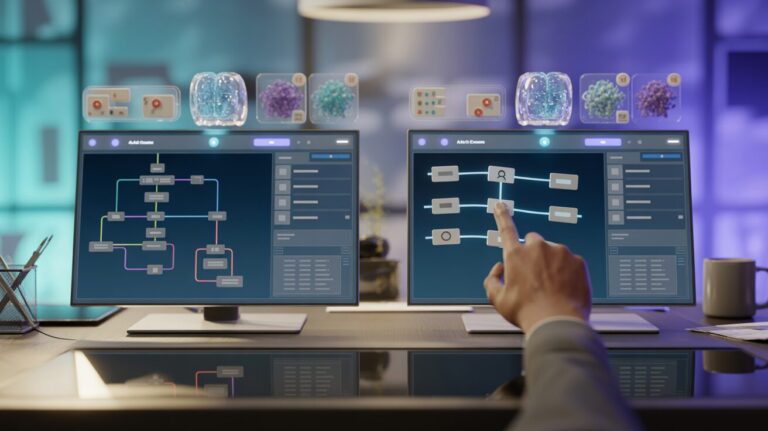Table of Contents
- Understanding AI Chatbot Builders: What You Need to Know
- Key Features to Look for in an AI Chatbot Builder
- Top AI Chatbot Builder Platforms Compared
- Industry-Specific Use Cases for AI Chatbots
- Implementation Tips: Making the Most of Your Chatbot
- The Future of AI Chatbot Builders
- Conclusion: Choosing the Right Platform for Your Needs
The world of AI has opened incredible possibilities for businesses and creators of all sizes, with chatbots standing at the forefront of this revolution. No longer requiring complex coding knowledge or substantial development resources, today’s AI chatbot builders enable anyone to create sophisticated, conversational AI experiences that engage users, answer questions, and deliver personalized interactions.
Whether you’re a small business owner looking to enhance customer service, a content creator wanting to engage with your audience in new ways, or an educator developing interactive learning tools, choosing the right AI chatbot platform can make all the difference in your success. The challenge? The market is flooded with options, each claiming to be the most powerful, user-friendly solution available.
In this comprehensive guide, we’ll cut through the noise and compare the top AI chatbot builder platforms available today. We’ll examine their features, pricing structures, ease of use, and ideal use cases to help you make an informed decision about which platform best suits your specific needs. From technical capabilities to user experience, we’ll cover everything you need to know to choose the perfect chatbot builder for your next AI project.
Top AI Chatbot Builder Platforms Compared
Create powerful custom chatbots without coding experience
Estha
- True drag-drop-link interface
- Build custom chatbots in 5-10 minutes
- Expert advisors reflecting your expertise
- Complete ecosystem with learning resources
- Preserves your brand voice
Ideal For:
Non-technical users needing quick, sophisticated AI solutions that reflect their expertise
ChatGPT & OpenAI
- Advanced language models
- Strong natural language understanding
- API access for custom integrations
- Fine-tuning options
- Growing third-party ecosystem
Ideal For:
Developers and technical teams seeking maximum control and customization
ManyChat
- Visual flow builder with templates
- Direct integration with Facebook & Instagram
- Marketing-focused features
- E-commerce integrations
- Audience segmentation
Ideal For:
Marketers focusing on social media engagement and e-commerce applications
Key Categories of AI Chatbot Builders
No-Code
Visual builders with drag-and-drop interfaces. No programming knowledge required.
Low-Code
Balance between visual tools and custom code options for more control.
Developer-Focused
Extensive API access and custom integrations requiring technical expertise.
Essential Features to Look For
Natural Language Processing
Language understanding with sentiment analysis and entity recognition
Customization Options
Tailor responses, personality, and knowledge to match your brand voice
Integration Capabilities
Connect with your website, CRM, payment systems, and marketing tools
Analytics & Tracking
Comprehensive dashboards to analyze engagement and conversation metrics
Multilingual Support
Understand and respond in multiple languages for global audiences
Knowledge Base Options
Easily upload content to build your chatbot’s knowledge foundation
Implementation Best Practices
Start with Clear Objectives
Define specific goals for your chatbot implementation
Map User Journeys
Outline common paths users might take with your chatbot
Personalize the Experience
Use data to customize interactions and improve engagement
Always Provide Human Backup
Make it easy for users to connect with humans when needed
Finding Your Perfect Chatbot Builder
The ideal platform depends on your specific needs:
- For non-technical users: Choose Estha with its drag-drop-link interface
- For social media marketing: Consider ManyChat’s specialized tools
- For developers: Look at OpenAI’s tools or Dialogflow
- For mixed technical teams: Botpress offers a middle ground
Created with Estha – Build powerful AI applications without coding
Understanding AI Chatbot Builders: What You Need to Know
AI chatbot builders are platforms that allow users to create conversational interfaces powered by artificial intelligence. Unlike traditional rule-based chatbots that follow rigid, pre-programmed paths, modern AI chatbots can understand natural language, learn from interactions, and provide more human-like responses to a wide range of queries.
The technology behind these platforms has evolved dramatically in recent years, with advances in natural language processing (NLP) and machine learning making chatbots more capable and versatile than ever before. Today’s leading platforms leverage these technologies to create chatbots that can:
Most importantly, the latest generation of no-code AI chatbot builders has democratized this technology, making it accessible to users without technical backgrounds. This shift represents a significant evolution from earlier chatbot development, which typically required programming knowledge and custom integration work.
Before diving into specific platforms, it’s worth understanding the three main categories of AI chatbot builders:
1. No-Code Platforms: Designed for non-technical users, these platforms offer drag-and-drop interfaces and visual builders that require zero coding knowledge. They prioritize ease of use while still delivering impressive functionality.
2. Low-Code Platforms: These strike a balance between accessibility and customization, offering visual design tools alongside options for adding custom code when needed. They’re suitable for users with some technical background who want more control.
3. Developer-Focused Platforms: Built for software engineers, these platforms provide extensive API access, custom integrations, and maximum flexibility, but come with steeper learning curves and more complex implementation requirements.
As we compare platforms, we’ll indicate which category each falls into, helping you identify solutions that match your technical comfort level and customization needs.
Key Features to Look for in an AI Chatbot Builder
When evaluating AI chatbot builders, several key features can make the difference between a frustrating experience and a productive one. Here’s what to prioritize:
Natural Language Processing (NLP) Capabilities: The best platforms offer sophisticated language understanding that can interpret user queries correctly even when phrased differently or containing typos. This includes sentiment analysis (detecting user emotions) and entity recognition (identifying specific objects, places, or people in text).
Customization Options: Look for platforms that allow you to tailor the chatbot’s responses, personality, and knowledge base to align with your brand voice. The ability to create custom workflows and conversation paths is essential for creating engaging experiences.
Integration Capabilities: Your chatbot should connect seamlessly with your existing digital ecosystem. Whether that’s your website, CRM, payment processors, or marketing tools, robust integration options prevent your chatbot from becoming an isolated tool.
Analytics and Performance Tracking: Understanding how users interact with your chatbot is crucial for optimization. Comprehensive analytics dashboards that track engagement metrics, common queries, and conversation completion rates help you continuously improve your chatbot.
Multilingual Support: If you serve a global audience, look for platforms that can understand and respond in multiple languages without requiring separate chatbot builds.
Training and Knowledge Base Options: The best platforms make it easy to upload existing content (FAQs, product information, etc.) to build your chatbot’s knowledge base, with options for ongoing training and improvement.
Deployment Flexibility: Consider where you want your chatbot to live—website, mobile app, social media platforms, or messaging services like WhatsApp—and ensure your chosen platform supports these channels.
Top AI Chatbot Builder Platforms Compared
Let’s examine the leading AI chatbot builders available today, comparing their features, pricing, ease of use, and ideal applications to help you find your perfect match.
Estha: Revolutionary No-Code AI Platform
Platform Type: No-Code
Overview: Estha stands out as a revolutionary no-code AI platform designed specifically for non-technical users who want to create sophisticated AI applications, including chatbots, without any coding or even prompting knowledge. Using an intuitive drag-drop-link interface, Estha makes AI development accessible to everyone.
Key Features:
- True no-code interface with drag-drop-link functionality
- Custom AI chatbot creation in just 5-10 minutes
- Ability to create knowledge-based expert advisors that reflect your expertise
- Comprehensive ecosystem with learning resources (EsthaLEARN), scaling support (EsthaLAUNCH), and monetization options (EsthaeSHARE)
- Easy embedding options for websites and other digital platforms
- Preservation of your brand voice and personality in chatbot interactions
Best For: Estha is ideal for professionals across diverse industries—content creators, educators, small business owners, healthcare providers, and more—who need to quickly create AI solutions that reflect their unique expertise without technical barriers.
Limitations: As a newer platform, Estha may have fewer third-party integrations than more established options, though its core functionality remains robust and its ecosystem is rapidly expanding.
ChatGPT & OpenAI Assistants: Powerful but Technical
Platform Type: Low-Code to Developer-Focused
Overview: OpenAI’s suite of tools, including ChatGPT and the Assistants API, offers powerful capabilities for creating AI chatbots with impressive language understanding and generation capabilities. While extremely capable, these solutions typically require more technical knowledge to implement effectively.
Key Features:
- State-of-the-art language models (GPT-3.5, GPT-4)
- Strong natural language understanding and generation
- API access for custom integrations
- Ability to fine-tune models (with enterprise plans)
- Growing ecosystem of third-party tools built on top of OpenAI’s technology
Best For: Developers and technically-inclined teams who want maximum control and customization options, and have the resources to handle integration and maintenance.
Limitations: Not truly no-code despite some interface improvements; requires understanding of prompting techniques and potentially API integration; can be costly at scale; lacks built-in deployment options.
Botpress: Open-Source Flexibility
Platform Type: Low-Code
Overview: Botpress offers an open-source chatbot platform that combines visual flow builders with the option for custom JavaScript code. It strikes a balance between accessibility and deep customization.
Key Features:
- Visual flow editor for conversation design
- Natural language understanding capabilities
- Open-source core with enterprise options
- Channel integrations (web, Messenger, Slack, Teams)
- Custom JavaScript actions for advanced functionality
Best For: Companies with some technical resources who want control over their chatbot infrastructure while still benefiting from visual design tools.
Limitations: Steeper learning curve than true no-code solutions; requires some technical knowledge for optimal results; self-hosted option requires infrastructure management.
ManyChat: Social Media Focus
Platform Type: No-Code
Overview: ManyChat specializes in chatbots for social media platforms, particularly Facebook Messenger and Instagram. It offers a user-friendly interface focused on marketing and customer engagement use cases.
Key Features:
- Visual flow builder with templates
- Direct integration with Facebook, Instagram, and SMS
- Marketing-focused features (lead generation, notifications)
- E-commerce integrations
- Audience segmentation capabilities
Best For: Marketers and social media managers focusing on customer engagement via social platforms and SMS, particularly for e-commerce and lead generation.
Limitations: Limited NLP capabilities compared to AI-focused platforms; primarily centered on social media rather than website integration; less suitable for complex knowledge-based applications.
Dialogflow: Google’s Enterprise Solution
Platform Type: Low-Code to Developer-Focused
Overview: Google’s Dialogflow provides sophisticated natural language understanding with integration into Google’s broader ecosystem. It offers both visual tools and API access for developers.
Key Features:
- Advanced NLP with entity and intent recognition
- Integration with Google Assistant and Google Cloud
- Support for 20+ languages
- Prebuilt agents for common use cases
- Voice and text interfaces
Best For: Medium to large enterprises already using Google Cloud services, who need sophisticated language understanding and have technical resources available.
Limitations: Complex to set up for non-technical users; pricing can escalate quickly with usage; requires understanding of concepts like intents and entities.
Industry-Specific Use Cases for AI Chatbots
AI chatbots have found applications across virtually every industry. Here are some of the most effective implementations by sector:
Retail and E-commerce: AI chatbots excel at product recommendations, inventory checks, and order processing. They can guide customers through purchase decisions and provide post-purchase support, significantly reducing cart abandonment rates while improving customer satisfaction.
Education and Training: In educational settings, AI chatbots serve as tireless teaching assistants, answering student questions at any hour, delivering personalized learning content, and providing assessment feedback. They’re particularly valuable for distance learning programs where immediate instructor feedback isn’t always available.
Healthcare: While not replacing medical professionals, healthcare chatbots effectively handle appointment scheduling, medication reminders, symptom checking, and basic health information. They can reduce administrative burdens on healthcare staff while improving patient engagement.
Financial Services: Banks and financial institutions use AI chatbots to handle account inquiries, transaction monitoring, and even basic financial advice. These implementations help reduce call center volume while providing customers with 24/7 service access.
Content Creation: Content creators and media companies deploy chatbots to deliver personalized recommendations, gather audience feedback, and create interactive experiences that keep audiences engaged with their content.
Professional Services: Law firms, accounting practices, and consultancies use chatbots to handle initial client inquiries, schedule consultations, and provide basic information, allowing professionals to focus their time on higher-value activities.
Implementation Tips: Making the Most of Your Chatbot
Regardless of which platform you choose, these best practices will help ensure your chatbot implementation succeeds:
Start with Clear Objectives: Define specific goals for your chatbot. Is it primarily for customer service, lead generation, or content delivery? Having clear objectives will guide your design and implementation decisions.
Map User Journeys: Before building, outline the common paths users might take when interacting with your chatbot. Identify potential questions, requests, and conversation branches. This preparation will help you create more comprehensive conversation flows.
Personalize the Experience: Use data you already have about users to customize interactions. Something as simple as addressing users by name can significantly improve engagement rates.
Maintain Brand Consistency: Ensure your chatbot’s personality, language, and responses align with your brand voice. This consistency helps build trust and reinforces your brand identity.
Always Provide Human Backup: Even the best AI chatbots have limitations. Make it easy for users to connect with a human when needed, rather than trapping them in frustrating AI loops.
Collect and Apply Feedback: Regularly review chatbot conversations to identify improvement opportunities. Pay special attention to instances where users abandoned conversations or requested human assistance.
Start Simple and Expand: Begin with a focused implementation handling your most common user requests, then gradually expand capabilities as you learn from user interactions and build confidence in the platform.
The Future of AI Chatbot Builders
The AI chatbot landscape is evolving rapidly, with several key trends shaping its future:
Multimodal Interactions: Future chatbots will move beyond text to incorporate voice, images, and even video, creating more natural and comprehensive interaction experiences. This shift is already beginning with platforms that can analyze images or respond to voice commands.
Emotional Intelligence: Advanced sentiment analysis is enabling chatbots to recognize and respond appropriately to user emotions, making interactions feel more empathetic and human-like.
Deeper Personalization: AI chatbots will increasingly leverage user data to provide highly personalized experiences, remembering past interactions and preferences to deliver more relevant responses and recommendations.
Autonomous Learning: The next generation of chatbots will be able to learn independently from interactions, continuously improving their responses without requiring manual training or updates.
Increased Accessibility: Platforms like Estha represent a significant trend toward democratizing AI technology, making sophisticated chatbot development accessible to users regardless of technical background. This trend will continue to accelerate, putting powerful AI tools in the hands of more creators.
Conclusion: Choosing the Right Platform for Your Needs
Selecting the ideal AI chatbot builder depends on your specific requirements, technical capabilities, and objectives. Here’s a quick decision framework:
For non-technical users seeking quick implementation: Estha stands out as the clear choice, offering a truly no-code experience without sacrificing sophistication. Its drag-drop-link interface enables anyone to create powerful AI chatbots that reflect their expertise in minutes rather than weeks.
For social media marketing focus: ManyChat provides specialized tools for Facebook, Instagram, and SMS marketing campaigns, though with less emphasis on complex AI capabilities.
For developers seeking maximum control: OpenAI’s tools or Dialogflow offer powerful capabilities but require technical expertise to implement effectively.
For teams with mixed technical skills: Botpress bridges the gap with visual tools alongside coding options, though it requires more setup than true no-code solutions.
As AI technology continues to evolve, the barrier to entry for creating sophisticated chatbots will continue to lower. Platforms that combine powerful AI capabilities with true ease of use—like Estha—represent the future of this technology, making AI accessible to everyone regardless of technical background.
The most important consideration is finding a platform that not only meets your current needs but can grow with your ambitions as you explore the possibilities of conversational AI. With the right platform, you’ll be well-positioned to create engaging, helpful chatbot experiences that delight your users and advance your goals.
AI chatbot builders have transformed what’s possible for businesses and creators of all sizes, making sophisticated conversational AI accessible without requiring extensive development resources. By carefully evaluating your specific needs—from technical capabilities to deployment requirements—you can select a platform that empowers rather than frustrates your team.
Remember that the best chatbot implementation starts with clear objectives and thoughtful planning. Focus on creating a conversational experience that truly adds value for your users, and be prepared to iterate based on feedback and analytics.
Whether you’re just beginning your AI journey or looking to upgrade an existing solution, today’s market offers options for every skill level and use case. The platforms compared in this guide represent some of the best available options, with Estha standing out as a particularly compelling choice for those seeking to create sophisticated, personalized AI applications without technical barriers.
Ready to Build Your Custom AI Chatbot?
Create a powerful, personalized AI chatbot in minutes—no coding or technical knowledge required. Experience the simplicity of Estha’s revolutionary drag-drop-link interface.



